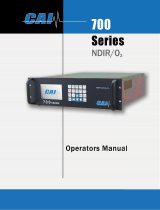
Instruction Manual
748467-A
January 2002
1-2 Description and Specifications Rosemount Analytical Inc. A Division of Emerson Process Management
Model MicroCEM
Other application-dependent options in-
clude a wide range of sample cell materi-
als, optical filters and solid state
detectors. The NDIR Microflow detector
consists of two chambers, measurement
and reference with an interconnected path
in which an ultra low flow filament sensor
is mounted. During operation, a pulsating
flow occurs between the two chambers
which is dependent upon: sample gas ab-
sorption, modulation by the chopper mo-
tor and the fill gas of the detector
chambers. The gas flow/sensor output is
proportional to the measured gas con-
centration. The optical bench is further
enhanced by a novel “Look-through” de-
tector technique. This design allows two
detectors to be arranged in series --- ena-
bling two different components to be
measured on a single optical bench. The
optical bench contains a unique eddy cur-
rent drive chopper motor and source as-
sembly. This design incorporates on
board “intelligence” to provide continuous
“self test” diagnostics.
c. Paramagnetic O
2
The determination of oxygen is based on
the measurement of the magnetic sus-
ceptibility of the sample gas. Oxygen is
strongly paramagnetic, while other com-
mon gases are not. The detector used is
compact, has fast response and a wide
dynamic range. The long life cell is corro-
sion resistant, heated and may be easily
cleaned. It has rugged self-tensioning
suspension and is of welded non-glued
construction.
1-4 DETECTOR METHODOLOGIES
The MicroCEM can employ up to three differ-
ent measuring methods depending on the
configuration chosen. The methods are:
NDIR, Paramagnetic O
2
, Electrochemical O
2
,
and Chemiluminescense.
a. Non-Dispersive Infrared (NDIR)
The non-dispersive infrared method is
based on the principle of absorption of in-
frared radiation by the sample gas being
measured. The gas-specific wavelengths
of the absorption bands characterize the
type of gas while the strength of the ab-
sorption gives a measure of the concen-
tration of the gas component being
measured.
An optical bench is employed comprising
an infrared light source, two analysis cells
(reference and measurement), a chopper
wheel to alternate the radiation intensity
between the reference and measurement
side, and a photometer detector. The de-
tector signal thus alternates between con-
centration dependent and concentration
independent values. The difference be-
tween the two is a reliable measure of the
concentration of the absorbing gas com-
ponent.
Depending on the gas being measured
and its concentration, one of two different
measuring methods may be used as fol-
lows:
Interference Filter Correlation (IFC)
Method
With the IFC method the analysis cell is
alternately illuminated with filtered infrared
concentrated in one of two spectrally
separated wavelength ranges. One of
these two wavelength bands is chosen to
coincide with an absorption band of the
sample gas and the other is chosen such
that none of the gas constituents ex-
pected to be encountered in practice ab-
sorbs anywhere within the band.
The spectral transmittance curves of the
interference filters used in the MicroCEM
analyzer and the spectral absorption of
the gases CO and CO
2
are shown in Fig-
ure 1-1. It can be seen that the absorption
bands of these gases each coincide with
the passbands of one of the interference
filters. The forth interference filter, used
for generating a reference signal, has its
passband in a spectral region where none
of these gases absorb. Most of the other
gases of interest also do not absorb within
the passband of this reference filter.





















